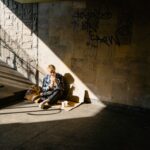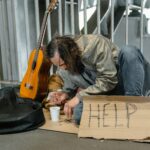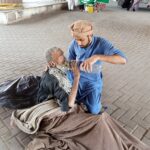Over the past two years, COVID-19 has had many Americans thinking about their health. The pandemic has also caused other important topics to rise to the surface, such as:
- Science
- Medical ethics
- Gender equality
- Social justice
- Racial justice
- Personal freedoms
One topic that has failed to garner much attention in light of the pandemic is homelessness. The homeless community seems to be far from the minds of politicians, professors, educational institutions, neighbors, and even social media and its influencers. In fact, in countless conversations about COVID-19 guidelines and regulations, the homeless population was forgotten. It’s as if they are invisible or on the outside of what is going on.
Pre- and Post- COVID Homelessness
Before the global COVID-19 pandemic, approximately 553,742 Americans experienced homelessness on a given night. An estimated 100,000 children were homeless each day, and 50 percent of these children were under five years old. Since the pandemic began, these numbers have continued to climb thanks to several factors such as:
- Businesses closing
- Jobs lost
- High medical bills from COVID-19 inpatient care
Being homeless in America is challenging, and COVID-19 has only proven to make it more so. Federal and state mandates and guidelines arose:
- Wash or sanitize hands frequently
- Social distance at least 6-feet from others
- Use telemedicine instead of going to the doctor or urgent care
- Stay home if you have a fever or don’t feel well
Those without homes don’t have easily accessible running water, phones, or internet, especially when restaurants, libraries, and other places are closed. How are they supposed to wash their hands frequently or access telemedicine? What home are they supposed to stay in if they have a fever or aren’t feeling well? How do you social distance in a homeless encampment or even a tiny house with one bedroom or bathroom? Where can the homeless access medical care without access to
telemedicine, closed urgent care, and other clinics? It seems not many stopped to think about these pressing questions.
Overnight the communities, centers, and churches homeless individuals relied upon disappeared. Instead of having more support and resources as they needed, they had less.
The Link Between Homelessness and Health
Housing and health are undoubtedly linked. Americans who have permanent housing have a life expectancy of 80 years. On the other hand, chronically homeless people only have a life expectancy of 60 years. In fact, sick people are often the most at risk of becoming homeless. Once homeless, a downward spiral begins, and they only become sicker and more vulnerable. The homeless population is arguably the most at-risk group to have faced the COVID-19 pandemic, and in many cities across the nation, they are forgotten.
The Homeless: Forgotten Before and During COVID
Some American cities with substantial homeless populations recognized some of these obstacles and attempted to help. Cities such as Colorado Springs, Denver, Los Angeles, San Francisco, Phoenix, and Washington D.C. looked into:
- Means of sanitization
- Potential temporary housing options to decrease the spread of COVID-19
- Distributing of water and food
- Implementing free and easy testing sites near homeless encampments
A handful of cities were successful in helping their homeless communities during this unprecedented and most unusual time. Yet, most cities let their ideas fade away, losing sight of their intentions before they could implement them.
How can you tell this vulnerable population has been forgotten in this pandemic? Go online and find how many active cases of COVID there are in your area, how many are hospitalized, or how many recent deaths there have been. Homeless individuals are likely not included in these figures. However, no one appears to have any idea how many homeless American individuals died as a result of the pandemic.
In big cities with significant homeless populations in which COVID-19 cases skyrocketed, the homeless people who came down with and passed away from COVID-19 are yet to be accounted for. Homeless communities weren’t a part of the large COVID-19 conversation. They were never even considered in other issues before the pandemic began. Society seems to have forgotten that the homeless are still members of the community, members who have been and will continue to be impacted by the coronavirus. This inequity must become a part of the larger discussion.
Our Obligation to Humanity Includes the Homeless
We can’t put an end to the pandemic without including the homeless population in the conversation. We have an obligation to care for them during the pandemic just as we would anyone else—and many of us did help others. Why do we have this obligation? If you think about it, by protecting the homeless population from the virus, we are also protecting society. Even if you discount that fact, we should protect the homeless from the virus simply because they are human beings. No one deserves to be forgotten, especially during a global pandemic.
How is SRF helping?
We at Sam Risso Foundation work closely with other non-profits such as the Burrito Project and Restoration Bridge to make sure the unhoused have access to resources and basic necessities they need. We have implemented Project Basic Necessity in which we create and hand out hundreds of care packages containing basic hygiene supplies to those unhoused.
Every second Saturday of the month at 10 AM we hold a community resource event at Church By the Glades where people can come get food, hygiene supplies, showers and receive access to laundry machines and medical care resources.
We could not have done any of this without your support. If you would like to donate to contribute to Project Basic Necessity click the link or visit our Instagram or Facebook @samrissofoundation. No amount is too small and we can only continue to do the work we do with your help.



